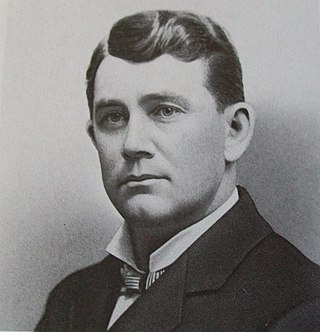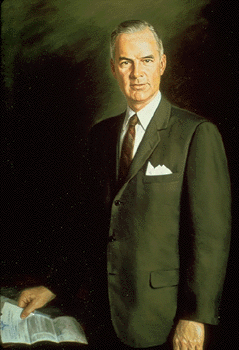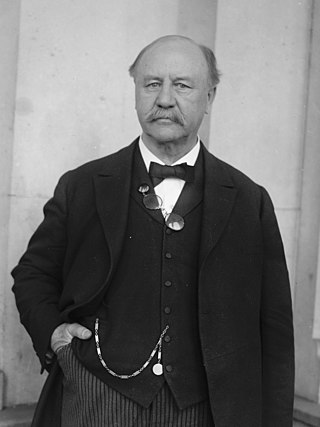
Thomas Andrews Hendricks was an American politician and lawyer from Indiana who served as the 16th governor of Indiana from 1873 to 1877 and the 21st vice president of the United States from March until his death in November 1885. Hendricks represented Indiana in the U.S. House of Representatives (1851–1855) and the U.S. Senate (1863–1869). He also represented Shelby County, Indiana, in the Indiana General Assembly (1848–1850) and as a delegate to the 1851 Indiana constitutional convention. In addition, Hendricks served as commissioner of the United States General Land Office (1855–1859). Hendricks, a popular member of the Democratic Party, was a fiscal conservative. He defended the Democratic position in the U.S. Senate during the American Civil War and Reconstruction era and voted against the Thirteenth, Fourteenth, and Fifteenth Amendments to the U.S. Constitution. He also opposed Radical Reconstruction and President Andrew Johnson's removal from office following Johnson's impeachment in the U.S. House.

Oliver Hazard Perry Throck Morton, commonly known as Oliver P. Morton, was a U.S. Republican Party politician from Indiana. He served as the 14th governor of Indiana during the American Civil War, and was a stalwart ally of President Abraham Lincoln. Morton worked hard to maximize Indiana's contribution to the war effort and marginalize the obstructionists. He was a principled and effective leader who fought for equality and nationalism through the use of governmental power. His forceful pursuit of civil rights and prosecution of Copperheads and white supremacists gained him lasting enemies among the antiwar elements. Morton thwarted and neutralized the Democratic-controlled Indiana General Assembly. He exceeded his constitutional authority by calling out the militia without approval, and during the period of legislative suppression he privately financed the state government through unapproved federal and private loans. He was criticized for arresting and detaining political enemies and suspected southern sympathizers. As one of President Lincoln's "war governors", Morton made significant contributions to the war effort, more than any other man in the state, and earned the lifelong gratitude of former Union soldiers for his support.

James Franklin Hanly was an American politician who served as a congressman from Indiana from 1895 until 1897, and was the 26th governor of Indiana from 1905 to 1909. He was the founder of Hanly's Flying Squadron, which advocated prohibition nationally and played an important role in arousing public support for prohibition.

Edward L. Jackson was an American attorney, judge and politician, elected the 32nd governor of the U.S. state of Indiana from January 12, 1925, to January 14, 1929. He had also been elected as Secretary of State of Indiana.

Paris Chipman Dunning was a Democratic state representative, state senator, senate president pro tempore, the tenth lieutenant governor, and the ninth governor of the U.S. state of Indiana from December 26, 1848, to December 5, 1849. He is the only person to hold to every elected seat in the state government under the 1816 constitution. His brief term as governor was marked by the calling of a state constitutional convention and overshadowed by the national anti-slavery debate, where Dunning urged state leaders to issue and forward resolutions to Congress expressing opposition to the expansion of slavery. As a delegate to the subsequent convention, he successfully advocated legislative and educational reform. As the American Civil War broke out, he left the Democratic party and declared for the Union, personally raising many companies of soldiers for the war effort. He returned to the state senate during the war, and then resumed his law practice after his term ended. He remained popular in the state, and declined several nominations to run for office after retiring from politics.

Harry Guyer Leslie was an American politician and Indiana Republican Party member, speaker of the state house and the 33rd governor of the state. His term as governor was marked by the start of the Great Depression.

James Putnam Goodrich was an American politician and member of the Republican Party who served as the 29th governor of Indiana from 1917 to 1921. His term focused on reforming the operations of the state government and overseeing the state's contributions to World War I. He nearly died twice during his term, and spent a considerable time bedridden. Following his term as governor, he became increasingly wealthy from his business interests and owned a controlling share in many companies.

Matthew Empson Welsh was an American politician who was the 41st governor of Indiana and a member of the Democratic Party, serving from 1961 to 1965. His term as governor saw a major increase in statewide taxation, including the first state sales tax, and the passage of several important civil rights bills, making Indiana one of the most friendly states to ethnic and religious minorities at that time. His tax hikes led to a near-tax revolt in the state, and people began writing "Indiana—Land of Taxes" on their license plates, at entry points into the state, in stores, and other public places. The situation killed any chance he had seeking higher office and earned him the moniker "Sales Tax Matt". Despite numerous reforms and his popularity within the Democratic Party, he was defeated when he ran for governor again in 1972. After leaving office, he served as chairman of the Indiana Democratic Party, as a member of the Democratic National Committee from 1964 until 1968, and as a federal commissioner on the International Joint Commission from 1966 until 1970. Throughout his life, Welsh was known for his personal motto, "It doesn't cost you anything to be a gentleman." After his retirement in 1972, he returned to Indianapolis, where he remained until his death in 1995.

Roger Douglas Branigin was an American politician who was the 42nd governor of Indiana, serving from January 11, 1965, to January 13, 1969. A World War II veteran and well-known public speaker, Branigin took office with a Democratic general assembly, the first time since the Great Depression that Democrats controlled both the executive and legislative branches of the Indiana state government. Branigin was a conservative Democrat who oversaw repeal of the state's personal property taxes on household goods, increased access to higher education, and began construction of Indiana's deep-water port at Burns Harbor on Lake Michigan. During his one term as governor, Branigin exercised his veto power one hundred times, a record number for a single term. Branigin was the last Democrat to serve as governor of Indiana until Evan Bayh took office in 1989.

Ashbel Parsons Willard was state senator, the 12th lieutenant governor, and the 11th governor of the U.S. state of Indiana. His terms in office were marked by increasingly severe partisanship leading to the breakup of the state Democratic Party in the years leading up to the American Civil War. His brother-in-law John Edwin Cook was involved in John Brown's raid on Harpers Ferry, and was executed. Willard went to the south to advocate unsuccessfully for his release, and became despised by southerners who accused him of having a secret involvement in the raid. He died two months before the start of the war while giving a speech on national unity, and was the first governor of Indiana to die in office.

Maurice Clifford Townsend was an American politician and the 35th governor of the U.S. state of Indiana from 1937 to 1941. During his term, he led relief efforts during and after the Great Flood of 1937.

Isaac Pusey Gray was the 18th and 20th governor of the U.S. state of Indiana from 1880 to 1881 and from 1885 to 1889. Originally a Republican, he oversaw the forceful passage of the post-American Civil War constitutional amendments while he was a member of the Indiana Senate. He became a Democrat following the corruption of the Administration of Ulysses S. Grant but was regularly stymied by his Democratic adversaries who constantly referred to his tactics while a Republican, earning him the nickname "Sisyphus of the Wabash."

Claude Matthews was an American politician who served as the 23rd governor of the U.S. state of Indiana from 1893 to 1897. A farmer, he was nominated to prevent the loss of voters to the Populist Party. The Panic of 1893 occurred just before he took office, leading to severe economic problems during his term. Republicans took the Indiana General Assembly in the 1894 mid-term election and repudiated many of the Democrats' laws, leading to violence in the assembly. A popular party figure when he left office, he was a nominee to run for president at the 1896 Democratic National Convention, but lost his bid for the nomination to William Jennings Bryan.

Samuel Moffett Ralston was an American politician of the Democratic Party who served as the 28th governor of the U.S. state of Indiana and a United States senator from Indiana.

Warren Terry McCray was the 30th governor of the U.S. state of Indiana from 1921 to 1924.

Henry Frederick Schricker was an American politician who served as the 36th and 38th Governor of the U.S. state of Indiana from 1941 to 1945 and from 1949 to 1953. He is the only Indiana governor elected to two non-consecutive terms, and the only governor between 1852 and 1977 to be elected to more than one term in office. His terms were marked by strong opposition party control of the Indiana General Assembly, which attempted to remove powers from the governor that had been granted during the Great Depression. Schricker fought the attempt in the state courts, and although his power was significantly reduced, the Indiana Supreme Court ruled in the case of Tucker v. Indiana that the governor was the chief executive of the state, and the legislature could not pass legislation that interfered with the division of powers.

George North Craig was an American attorney and politician who served as the 39th governor of the U.S. state of Indiana from 1953 until 1957. A lawyer and veteran of World War II who was promoted to serve in a division command staff, Craig first gained popularity in the state as National Commander of The American Legion. He was a political outsider when he ran for governor and was at odds with more conservative party leadership during his time in office. Although he made significant reforms, his term ended with a high-profile bribery scandal when it was found that several high-level state employees had been accepting bribes to influence their decision in assigning construction contracts. Craig was personally uninvolved in the scandal but was held responsible for it by the public, ending his political career.

Harold Willis Handley was the 40th governor of the U.S. state of Indiana from 1957 to 1961. A veteran of World War II, and furniture salesman by trade, Handley began his political career as a state senator. Thanks to his longtime friendship with state party leader and United States Senator William E. Jenner, he was able to secure the nomination to run for lieutenant governor in 1952, during which time he opposed many of the actions of Governor George N. Craig. His popularity rose among the conservative leadership of the Indiana Republican Party and aided him in winning the nomination and subsequent election as governor in 1956.

Albert Gallatin Porter was an American politician who served as the 19th governor of Indiana from 1881 to 1885 and as a United States Congressman from 1859 to 1863. Originally a Democrat, he joined the Republican Party in 1856 after being expelled by the pro-slavery faction of the Democratic Party. Only the second person born in Indiana to become the state's governor, he reluctantly accepted his party's nomination to run. His term saw the start of Indiana's industrialization that continued for several decades. During the second half of his term a strong Democratic majority took control of the Indiana General Assembly and revoked all of the governor's appointment powers and other authorities, weakening the governors position to its lowest state in the history of the state.

The Indiana Republican Party is the affiliate of the United States Republican Party in the state of Indiana. The chairman of the Indiana Republican State Committee is Anne Hathaway.























